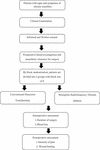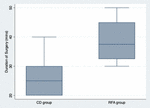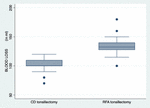Introduction
Tonsillectomy is one of the most routinely performed surgeries in otolaryngology. Described techniques for performing tonsillectomy include blunt dissection, bipolar and monopolar diathermy, bipolar scissor dissection, guillotine excision, radiofrequency ablation, cryosurgery, ultrasonic scalpel, laser dissection, and coblation-assisted tonsillectomy (1). Even after all these years, surgeons differ in their opinions regarding the optimal technique of tonsillectomy that causes the least morbidity. But the majority of surgeons still prefer conventional dissection tonsillectomy to other newly developed techniques.
Monopolar radiofrequency thermal ablation transfers radiofrequency energy to the tonsil tissue through probes inserted in the tonsil. The thermal damage caused by radiofrequency heat produces irreversible cellular damage (2). Hence, radiofrequency ablation should preferably cause less postoperative pain and intraoperative bleeding, resulting in early patient recovery with a reduced risk of postoperative complications. Different studies have been done to compare the efficacy of bipolar radiofrequency tonsillectomy, coblation tonsillectomy, and conventional dissection tonsillectomy. As the results were contradictory, further randomized control studies are required. No much study has been done comparing monopolar radiofrequency thermal ablation and conventional dissection tonsillectomy. Hence, we have done a randomized control trial to compare the efficacy of monopolar radiofrequency thermal ablation over conventional dissection tonsillectomy in terms of intraoperative duration, bleeding, postoperative pain, and healing.
Methodology
This study was a non-inferiority randomized control trial (Registration number: CTRI/2020/04/024417) that involved 56 patients above 14 years of age who visited the Department of ENT, Mahatma Gandhi Medical College and Research Institute within the period of April 2020–January 2021 with signs and symptoms of chronic tonsillitis, hypertrophy of tonsils causing obstructive sleep apnoea and those who failed medical therapy. Patients with active infections, bleeding disorders, uncontrolled diabetes mellitus, hypertension, coronary artery disease, bronchial asthma, and those with contraindications to general anesthesia were excluded from the study. After getting Institutional Medical Ethical Committee approval and written informed consent, the study population was divided into two groups by block randomization with a block size of 8. The sample size was calculated using Sealed Envelope Ltd 2012. Group 1 underwent conventional dissection (CD) tonsillectomy and group 2 underwent monopolar radiofrequency ablation (RFA).
Intraoperatively, the duration of surgery and the amount of blood loss were evaluated. The operative time was kept by an independent nurse and estimated from insertion to removal of the Boyle Davis mouth gag. Blood loss was calculated by visual estimation (3).
Postoperatively, intensity of pain was analyzed using the Visual Analogue Scale (VAS) of pain scoring, which is a numerical pain scale numbered from 0 to 10. The time required for wound healing was compared between the two surgeries. Healing was assessed one week after the tonsillectomy when the patient came for review based on the percentage of unhealed raw area.
Grade 1−raw area 25% or less
Grade 2−25–50%
Grade 3−50–75%
Grade 4−more than 75%
The patients were evaluated on postoperative days 0–3 and discharged on the 3rd postoperative day in the absence of any postoperative complications. The patients were then followed up at the end of the 1st week, 2nd week, and 1 month post-operatively. The results obtained were recorded and statistically analyzed using an independent t test and Mann–Whitney test.
Results
Algorithm
The mean age of patients in both groups was 24.96 with female predominance. Recurrent throat pain followed by odynophagia was found to be the most common presenting complaint in patients with chronic tonsillitis. In our study, 85.7% of the study population had grade 3 tonsil enlargement in CD group and 89.3% of patients had grade 3 tonsil enlargement in RFA group.
The intraoperative duration was calculated using mean and standard deviation. The mean operative duration in the CD group was found to be 42.14 min, whereas it was 72.5 min in the RFA group and the p-value was found to be significant, i.e., p < 0.001 (Figure 1).
Intraoperative blood loss was compared between the two groups using the mean and standard deviation. The mean blood loss in CD group was estimated to be 101.43 ml while in RFA group it was 134.11 ml and the p-value was <0.001, which makes it statistically significant (Figure 2).
The comparison of postoperative pain in CD and RFA group from postoperative day 0 to day 30 was analyzed using the mean, median, and Friedman test and the pain was found to decrease periodically over time with a significant p-value of <0.001. Association of VAS score between the two groups was calculated using the mean, median, and Mann–Whitney test, where the p-value was found to be significant on postoperative day 0 and day 1 with values <0.001 and 0.001, respectively, indicating less pain for the RFA group. Thereafter there were no significant difference between the two groups (Table 1).
All patients in the study population had either grade 3 or grade 4 of healing on the day of surgery, i.e., (50–75% of unhealed raw area and >75% of unhealed raw area, respectively). It was compared between the two groups using the mean, median, and Mann–Whitney test. The results were suggestive of better healing in the RFA group when compared to the CD group on day 0, with a significant p-value of 0.003 (Table 2).
Thus, the study shows that RFA is associated with longer operative duration and blood loss, even though postoperative pain on day 0 and 1 was less when compared to the CD technique. Post-operative healing was found to be the same between the two groups without any statistically significant difference.
Discussion
In our study, the mean age of study population was found to be 24.96 in both groups with female predominance. In both the groups, recurrent episodes of throat pain were found to be the most common presenting symptom. Also, CD tonsillectomy was associated with less intraoperative duration and bleeding when compared to monopolar RFA.
A prospective randomized clinical trial was conducted by Neemati et al. to compare bipolar radiofrequency (RF) tonsillotomy with traditional CD tonsillectomy among 62 adult patients with recurrent tonsillitis. A RF tonsillotomy was performed by probing 5 points of tonsillar crypts in grade 1 tonsillitis, 7 points in grade 3 tonsillitis, and 9 points in grade 4 tonsillitis. The intraoperative duration was compared between the 2 procedures and the mean duration was found to be 16.89 +/− 6.04 minutes in RF tonsillotomy and 46.07 +/− 10.3 min in CD tonsillectomy. The increased duration may be due to the complete removal of the tonsil in CD tonsillectomy when compared to the partial removal of the tonsil in bipolar RF tonsillotomy (4).
A prospective randomized control trial conducted by Muthubabu et al. to compare CD and coblation techniques of tonsillectomy among a study population of 60 patients showed that the mean duration was more with the coblation technique with 32.8 min (5). Similarly, in our study the mean intraoperative duration was found to be 38.2 min in RFA and 24.8 min in CD tonsillectomy. This may be due to difficulty in attaining the plane of dissection and also increased bleeding, which in turn compromised the visualization of surgical plane with RFA.
According to the study conducted by Torres et al. bleeding was found to be the most common complication (6). On comparing the intraoperative blood loss between different techniques by Ragab et al. the mean blood loss was found to be low with bipolar RF followed by ultrasonic scalpel and CD tonsillectomy. The reduced blood loss with RF was thought to be due to less tissue damage caused and also since the RF helps in coagulating and disrupting the tonsil pedicle at the same time. However, in our study the mean blood loss was higher with RFA than in the CD group (7). The mean blood loss with CD was found to be 101.43 ml and that of RFA was 134.11 ml with a significant p-value of <0.001. This may be due to the deeper thermal damage induced by the monopolar probe, whereas bipolar RFA in the previous study caused only superficial thermal effects. No postoperative hemorrhage was reported in either group.
Post-operative pain in tonsillectomy occurs due to the presence of exposed nerve fibers and muscle fibers within the open wound. Once they are exposed to the pharyngeal environment, tissues get inflamed and muscle spasm occurs. In the retrospective study conducted by Verma et al. to compare the different techniques of tonsillectomy, monopolar RFA was found to have less postoperative pain when compared to CD tonsillectomy (8).
The role of hypertonic saline in monopolar tonsillectomy was assessed among the pediatric population by Ma et al. (9). The study concluded that hypertonic injection reduces the postoperative pain by (i) Pushing the tonsil medially and preventing injury to the muscle (ii) Absorbing of part of the heat generated by the electrocautery (iii) Improving conduction of organ, thereby improving the efficacy of electrocautery (iv) Reducing cautery induced damage to the vessels.
Bogrul et al. compared postoperative pain and collateral tissue damage between bipolar RF, plasma blade, and CD tonsillectomy (10). Increased postoperative pain was noticed in the plasma and bipolar RF group when compared to the CD group. This was, however, contradictory to our study in which monopolar RFA was associated with less postoperative pain than CD tonsillectomy with a p-value of <0.001 in postoperative days 1 and 2. No significant statistical difference was found after day 2.
The healing of oral mucosal wound post tonsillectomy has been poorly studied. A review of literature was done by Davidoss et al. regarding wound healing in post tonsillectomy patients. Healing occurs by secondary intention, with keratinized squamous epithelium healing over the wound bed. It occurs in three stages: early, intermediate, and late stages. The early stage (24 to 48 h) reveals soft tissue edema, inflammatory exudate along with oral commensal bacteria causing fibrinous clot and uvula edema. The intermediate proliferative stage (Days 5 to 14) results in epithelialization. By day 5, white material fills the tonsillar fossa and peripheral epithelial edges grow inward with pink mucosa by day 7. By day 9, the pink epithelial edges cover larger areas and by day 12, they cover the entire wound bed. Complete epithelialization occurs in the late stage after day 14 (11). Several studies have been conducted to compare the postoperative wound healing between different techniques of tonsillectomy. It was found that wound healing was faster with CD tonsillectomy when compared to other thermal and laser techniques due to reduced tissue damage with CD. The same findings were obtained in our study except for postoperative day 1, where reduced slough formation was seen with RFA group with a p-value of 0.003. But thereafter, the difference between the two groups was insignificant and both groups took the same time for complete recovery.
Hence, our study shows that monopolar radiofrequency ablation does not have any added benefits when compared to the traditional technique of dissection tonsillectomy, as it is associated with more operative duration and intraoperative bleeding.
Conclusion
Different techniques of tonsillectomy have been described in the literature till date with each technique having its own advantages and disadvantages. There are numerous studies with bipolar radiofrequency ablation and very few studies with monopolar radiofrequency ablation compared to traditional cold dissection tonsillectomy. Even though the studies show variable results, we would like to conclude that the traditional conventional dissection tonsillectomy is better than monopolar radiofrequency ablation in terms of short operative duration and intraoperative bleeding, even though monopolar radiofrequency ablation seems to be better than conventional dissection tonsillectomy in terms of postoperative pain. But further multicentric trials with a larger study population need to be conducted in the future.
Disclosure of interest
None.
Funding
Nil.
References
1. Flint P, Haughey B, Robbins K, Thomas J, Niparko J, Lund V, et al. Cummings otolaryngology - head and neck surgery E-book. London: Elsevier Health Sciences (2014). p. 4198.
2. Isaacson G, Parikh T. Developmental anatomy of the tonsil and its implications for intracapsular tonsillectomy. Int J Pediatr Otorhinolaryngol. (2008) 72:89–96. doi: 10.1016/j.ijporl.2007.09.021
3. Ali Algadiem E, Aleisa A, Alsubaie H, Buhlaiqah N, Algadeeb J, Alsneini H. Blood loss estimation using gauze visual analogue. Trauma Mon. (2016) 21:e34131.
4. Nemati S, Banan R, Kousha A. Bipolar radiofrequency tonsillotomy compared with traditional cold dissection tonsillectomy in adults with recurrent tonsillitis. Otolaryngol Head Neck Surg. (2010) 143:42–7. doi: 10.1016/j.otohns.2010.03.031
5. Muthubabu K, Rekha A, Thejas S, Vinayak R, Srinivasan M, Alagammai S, et al. Tonsillectomy by cold dissection and coblation techniques: A prospective comparative study. Indian J Otolaryngol Head Neck Surg. (2019) 71:665–70. doi: 10.1007/s12070-018-1472-7
6. Galindo Torres B, De Miguel García F, Whyte Orozco J. Tonsillectomy in adults: Analysis of indications and complications. Auris Nasus Larynx. (2018) 45:517–21. doi: 10.1016/j.anl.2017.08.012
7. Ragab S. Six years of evidence-based adult dissection tonsillectomy with ultrasonic scalpel, bipolar electrocautery, bipolar radiofrequency or “cold steel” dissection. J Laryngol Otol. (2012) 126:1056–62. doi: 10.1017/S0022215112002022
8. Verma R, Verma R, Verma R. Tonsillectomy-comparative study of various techniques and changing trend. Indian J Otolaryngol Head Neck Surg. (2017) 69:549–58. doi: 10.1007/s12070-017-1190-6
9. Ma J, Zheng M, Mu J, Cui P. The role of hypertonic saline in monopolar tonsillectomy in adult patients. Ear Nose Throat J. (2017) 96:E21–3. doi: 10.1007/s12070-014-0774-7
10. Boğrul M, Ünal A, Yılmaz F, Sancaktar M, Bakırtaş M. Comparison of two modern and conventional tonsillectomy techniques in terms of postoperative pain and collateral tissue damage. Eur Arch Oto-Rhino-Laryngol. (2019) 276:2061–7. doi: 10.1007/s00405-019-05464-y




